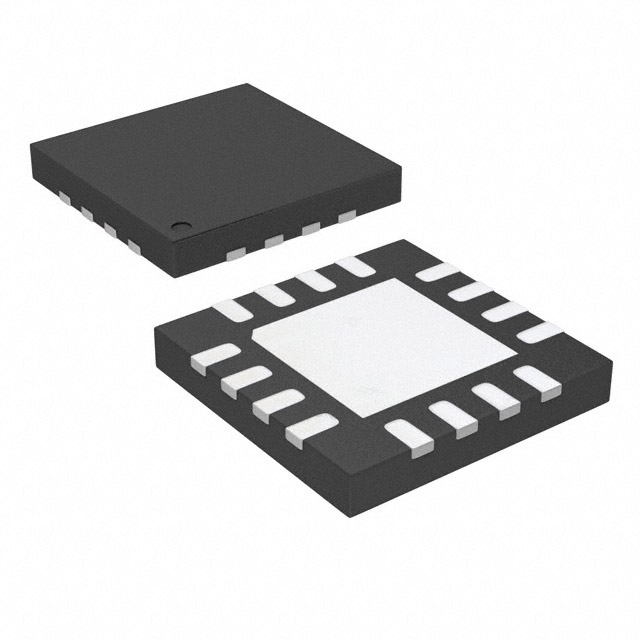Lihat spesifikasi untuk detail produk.

LTC2634CUD-LZ12#TRPBF
Product Overview
Category
The LTC2634CUD-LZ12#TRPBF belongs to the category of digital-to-analog converters (DACs).
Use
This product is commonly used in various applications that require precise analog voltage generation. It provides a high-resolution output signal that can be utilized in a wide range of electronic systems.
Characteristics
- High resolution: The LTC2634CUD-LZ12#TRPBF offers a resolution of 12 bits, allowing for fine-grained control over the generated analog voltage.
- Low power consumption: This DAC operates with low power requirements, making it suitable for battery-powered devices and energy-efficient designs.
- Fast settling time: The device features a fast settling time, enabling rapid response to changes in the input digital code.
- Wide operating voltage range: The LTC2634CUD-LZ12#TRPBF can operate within a wide voltage range, accommodating diverse system requirements.
Package
This product is available in a small form factor package, such as the 16-lead QFN (Quad Flat No-Lead) package. The compact size facilitates integration into space-constrained designs.
Essence
The essence of the LTC2634CUD-LZ12#TRPBF lies in its ability to convert digital signals into precise analog voltages. This conversion is crucial in numerous electronic systems where accurate analog voltage generation is required.
Packaging/Quantity
The LTC2634CUD-LZ12#TRPBF is typically packaged in reels or tape and reel packaging. The quantity per reel may vary depending on the manufacturer's specifications.
Specifications
- Resolution: 12 bits
- Number of channels: 1
- Output type: Voltage
- Operating voltage range: 2.7V to 5.5V
- Interface: SPI (Serial Peripheral Interface)
- Operating temperature range: -40°C to 85°C
- Package type: 16-lead QFN
Detailed Pin Configuration
The LTC2634CUD-LZ12#TRPBF features a 16-pin configuration. The pinout is as follows:
- VDD: Power supply voltage
- GND: Ground reference
- SCK: Serial clock input for SPI communication
- SDI: Serial data input for SPI communication
- LDAC: Load DAC input
- CS: Chip select input for SPI communication
- REF: Reference voltage input
- AGND: Analog ground reference
- OUT: Analog output voltage
- NC: No connection
- NC: No connection
- NC: No connection
- NC: No connection
- NC: No connection
- NC: No connection
- NC: No connection
Functional Features
- High accuracy: The LTC2634CUD-LZ12#TRPBF provides excellent linearity and low integral non-linearity, ensuring accurate analog voltage generation.
- Programmable output range: The device allows users to program the output voltage range according to their specific application requirements.
- Daisy-chain capability: Multiple LTC2634CUD-LZ12#TRPBF devices can be daisy-chained together, simplifying system integration and reducing the number of required control lines.
- Power-on reset: The DAC includes a power-on reset circuitry that ensures a known initial state upon power-up.
Advantages and Disadvantages
Advantages
- High resolution enables precise analog voltage generation.
- Low power consumption makes it suitable for energy-efficient designs.
- Fast settling time allows for rapid response to input changes.
- Wide operating voltage range accommodates diverse system requirements.
Disadvantages
- Limited number of channels (1 channel).
- Requires an external reference voltage for operation.
Working Principles
The LTC2634CUD-LZ12#TRPBF operates based on the principle of digital-to-analog conversion. It receives a digital input code through the SPI interface and converts it into a corresponding analog voltage output. The internal circuitry of the DAC accurately translates the digital code into a precise analog voltage, which can be utilized in various applications.
Detailed Application Field Plans
The LTC2634CUD-LZ12#TRPBF finds application in a wide range of fields, including but not limited to: - Industrial automation - Test and measurement equipment - Audio systems - Communication devices - Medical instruments - Automotive electronics
In industrial automation, this DAC can be used for controlling motor speed or position in precision machinery. In audio systems, it can be employed for volume control or tone adjustment. In medical instruments, it can assist in generating precise analog signals for diagnostic purposes.
Detailed and Complete Alternative Models
- LTC2634CUD-LZ10#TRPBF: 10-bit resolution DAC with similar features.
Sebutkan 10 pertanyaan dan jawaban umum terkait penerapan LTC2634CUD-LZ12#TRPBF dalam solusi teknis
Sure! Here are 10 common questions and answers related to the application of LTC2634CUD-LZ12#TRPBF in technical solutions:
Q: What is LTC2634CUD-LZ12#TRPBF? A: LTC2634CUD-LZ12#TRPBF is a digital-to-analog converter (DAC) chip manufactured by Linear Technology (now part of Analog Devices). It provides high-resolution analog output for various applications.
Q: What is the resolution of LTC2634CUD-LZ12#TRPBF? A: LTC2634CUD-LZ12#TRPBF has a resolution of 12 bits, which means it can provide 4096 discrete voltage levels.
Q: What is the operating voltage range of LTC2634CUD-LZ12#TRPBF? A: The operating voltage range of LTC2634CUD-LZ12#TRPBF is typically between 2.7V and 5.5V.
Q: How many channels does LTC2634CUD-LZ12#TRPBF have? A: LTC2634CUD-LZ12#TRPBF has four independent DAC channels, allowing you to control up to four analog outputs simultaneously.
Q: What is the output voltage range of LTC2634CUD-LZ12#TRPBF? A: The output voltage range of LTC2634CUD-LZ12#TRPBF is determined by the reference voltage applied to its VREF pin. It can be set to any voltage within the supply voltage range.
Q: Can LTC2634CUD-LZ12#TRPBF operate in both unipolar and bipolar modes? A: Yes, LTC2634CUD-LZ12#TRPBF can operate in both unipolar (0V to VREF) and bipolar (-VREF/2 to +VREF/2) modes, depending on the application requirements.
Q: What is the interface used to communicate with LTC2634CUD-LZ12#TRPBF? A: LTC2634CUD-LZ12#TRPBF supports a standard 3-wire SPI (Serial Peripheral Interface) for communication with microcontrollers or other digital devices.
Q: Does LTC2634CUD-LZ12#TRPBF have any internal voltage reference? A: No, LTC2634CUD-LZ12#TRPBF does not have an internal voltage reference. An external reference voltage must be provided to its VREF pin.
Q: Can LTC2634CUD-LZ12#TRPBF be used in precision measurement applications? A: Yes, LTC2634CUD-LZ12#TRPBF is suitable for precision measurement applications due to its high resolution and low integral non-linearity (INL) error.
Q: Are there any evaluation boards or development kits available for LTC2634CUD-LZ12#TRPBF? A: Yes, Analog Devices provides evaluation boards and development kits for LTC2634CUD-LZ12#TRPBF, which can help in prototyping and testing the chip in various applications.
Please note that the answers provided here are general and may vary based on specific datasheet specifications and application requirements.

